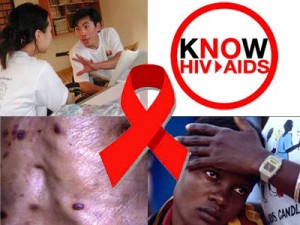Infection with the RNA retroviruses known as human immunodeficiency viruses (HIV) produces HIV infection which eventually damages T-lymphocytes that protects our immune system, thus causing immunodeficiency. This predisposes to fungi, viruses, mycobacteria and/or parasites, and the appearance of clinical diseases, at which time the condition is termed ‘HIV disease’. This then progresses over time to the acquired immune deficiency syndrome (AIDS).
What is acquired immune deficiency syndrome (AIDS)?
AIDS is defined as having CD4+ T-lymphocyte count at or below 200 cells/ml in the presence of HIV infection (the CD4+ T-lymphocyte count usually range from 500 to 1500 cells/ml in a healthy person). The definition includes 26 clinical conditions that affect persons with advanced HIV disease such as pulmonary tuberculosis, recurrent episodes of pneumonia or invasive cervical cancer. Premature death follows as AIDS mortality rate is virtually 100% although current anti-retroviral treatment can prolong this.
AIDS was first recognized in the USA in the early 1980s in the male gay population, although the infection has subsequently been recognized to have existed in Africa some decades before, as far back as 1959. The epidemic has spread worldwide from an African epicentre, largely in the socially excluded and in the developing world where HIV / AIDS is a leading cause of death in young adults and is increasing in children.
HIV is transmitted mainly by intimate sexual contact and can infect anyone who practices risky behaviors. Heterosexual intercourse is the main transmission route worldwide, is an important route in Africa and Asia, and is an increasingly important mode of transmission in the developed world, where it is responsible for 25 to 50% of cases. A major risk group in developed countries is still men who have sex with men.
Worldwide, sexually active adults continue to be the age group mainly affected, but the number of cases in children continues to rise, largely through the increasing prevalence of infection in pregnant females.
What are the predisposing factors and transmission of HIV?
HIV is present in tissues and body fluids (including blood and saliva) of HIV-infected persons. HIV is transmitted:
-
Readily through sharing needles and/or syringes (primarily for drug injection)
- Commonly by unprotected sexual intercourse with an infected person. The risk of transmission via various sexual practices varies; anal intercourse is more risky than vaginal; transmission by recipient of oral sex is far lower than transmission by recipient of anal sex.
-
Sometimes to babies born to HIV-infected women, before or during birth or through breast-feeding after birth.
-
Less commonly, through infusion of infected blood or blood clotting factors, or organ transplants
-
Rarely in the healthcare setting, by being stuck with needles or other sharps containing HIV-infected blood, or less frequently, after infected blood has entered a worker’s open cut or a mucous membrane (for example the mouth, eyes or inside of the nose)
-
Rarely by saliva, presumably because of protection from enzymes within saliva.
There is no reliable evidence for HIV transmission by normal social contact. HIV is not spread through casual contact such as sharing of food utensils, towels and bedding, swimming pools, telephones or lavatory seats. HIV is also not spread by biting insects such as mosquitoes or bedbugs.
Barrier precautions are highly effective at preventing transmission in all social and work situations, except for needlestick injuries. Transmission is best prevented by:
-
abstinence
-
being faithful
-
condom always
What is the cause and how does HIV infection develop?
There are two main HIV viruses responsible for HIV infection, but little difference between them in terms of manifestations of infection, treatment or prognosis. There are also several strains of each virus:
-
HIV-1 is by far the most common worldwide
-
HIV-2 has spread from West Africa mainly
Infection with HIV infects cells with CD4 receptors. Infected CD4+ cells becomes dysfunctional and die. The CD4 cell count falls and there is progressive immune deficiency and mental deterioration. T-cell-mediated immune protection thus diminishes, and patients become predisposed to infection with yeast and fungi, viruses, mycobacteria and parasites. Infections result from external pathogens or from commensal organisms (they cause no or little obvious harm in the immunocompetent host) that become opportunistic pathogens.
What are the clinical features of HIV infection?
Acute HIV infection
Acute HIV infection passes unrecognized in the majority since features are non-specific. In one-third to one-half of those infected, during the 4- to 7-week period of rapid viral replication immediately following exposure, there can be fever, body discomfort, enlargement of lymph nodes, muscle ache and other features closely mimicking glandular fever. High levels of HIV RNA are present in the blood.
HIV infection
This is a symptomless and variable period, often of years, when the virus is inactive. There is a massive presence of a virus in the blood stream with wide dissemination of HIV to lymphoid organs, but the resulting immune response only partially suppresses HIV, and some virus escapes, leading to the gradual deterioration of immune function and CD4+ T-cells.
To be continued in Part 2



